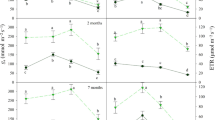Summary
Coryphantha vivipara (Nutt.) Britton & Rose var. deserti (Engelm.) W.T. Marshall (Cactaceae) survived snow and tissue temperatures of-12°C in southern Nevada. However, the freezing point depression of the cell sap was only about 0.9°C. When the nocturnal air temperature in the laboratory was reduced from 10°C to-10°C for one night, the optimum temperature for CO2 uptake shifted from 10°C to 6°C and uptake was reduced 70%, but full recovery to the original values occurred in 4 days. Nocturnal temperatures of-15°C killed 2 out of 5 plants and-20°C killed 5 out of 5, as judged by lack of net CO2 uptake at night over a 2-month observation period. when the stems were cooled at 2° C/h, supercooling to about-6°C occurred followed by an exothermic reaction that presumably represented the freezing of extracellular water. When the subzero temperature was lowered further, no other exothermic reaction was observed and the cells became progressively dehydrated. Freezing-induced tissue death was ascribed to this cellular dehydration, which led to about 94% loss of intracellular water at-15°C. when the tissue temperature was lowered, the ability of chlorenchyma cells to plasmolyze and to take up a stain decreased, both being nearly 70% inhibited at-15°C and completely abolished at-20°C. Some cold-bardening occurred, since lowering the air temperature from 30° to-10°C in 10°C increments at weekly intervals caused the subzero temperature for 50% inhibition of staining to decrease from-10°C to-17°C. Extension of the range of C. vivipara to regions with wintertime freezing apparently reflects the tolerance of considerable freeze dehydration by its protoplasts.
Similar content being viewed by others
References
Beatley JC (1976) Vascular plants of the Nevada Test Site and central-southern Nevada. Energy Research and Development Administration. Springfield, Virginia
Benson L (1974) The cacti of Arizona 3d ed. University of Arizona Press, Tucson
Burke MJ, Gusta LV, Quamme HA, Weiser CJ, Li PH (1976) Freezing and injury in plants. Ann Rev Plant Physiol 27:507–528
Dinger BE, Patten DT (1974) Carbon dioxide exchange and transpiration in species of Echinocereus (Cactaceae), as related to their distribution within the Pinaleno Mountains, Arizona. Oecologia (Berl) 14:389–411
Earle WH (1963) Cacti of the southwest. Arizona Cactus and Native Flora Society, Phoenix
George MF, Burke MJ, Pellet HM, Johnson AG (1974) Low temperature exotherms and woody plant distribution. HortScience 9:519–522
Hoagiand DR, Arnon DI (1950) The water-culture method for growing plants without soil. Calif Agric Exp Sta Circ 347:1–32
Jerdan PW, Nobel PS (1981) Seedling establishment of Ferocactus acanthodes in relation to drought. Ecology 62, in press
Kaku S, Iwaya M (1978) Low temperature exotherms in xylems of evergreen and deciduous broad-leaved trees in Japan with reference to freezing resistance and distribution range. In: Li, PH, Sakai A (eds) Plant cold hardiness and freezing stress. Academic Press, New York, p 227–239
Kaku S, Iwaya M (1979) Deep supercooling in xylems and ecological distribution in the genera Ilex, Viburnum and Quercus in Japan. Oikos 33:402–411
Kinride TB (1978) The ecological distribution of cholla cactus (Opuntia imbricata (Haw.) DC.) in El Paso County, Colorado. Southwestern Naturalist 23:117–134
Levitt J (1978) An overview of freezing injury and survival,and its interrelationships to other stresses. In: Li PH, Sakai A (eds) Plant cold hardiness and freezing stress. Academic Press, New York, p 3–15
Levitt J (1979) The role of proteins in the freezing injury and resistance of biological material. In: Fennema O (ed) Advances in chemistry series, No 180, Proteins at low temperature. American Chemical Society, Washington, DC
Levitt J (1980) Responses of plants to environmental stresses. 2d ed Vol 1 Chilling, freezing, and high temperature stresses. Academic Press, New York
Mazur P (1969) Freezing injury in plants. Ann Rev Plant Physiol 20:419–448
Niering WA, Whittaker HH, Lowe CH (1963) The saguaro: a population in relation to environment. Science 142:15–23
Nisbet RA, Patten DT (1974) Seasonal temperature acclimation of a prickly-pear cactus in south-central Arizona. Oecologia (Berl) 15:345–352
Nobel PS (1977) Water relations and photosynthesis of a barrel cactus, Ferocactus acanthodes, in the Colorado desert. Oecologia (Berl) 27:117–133
Nobel PS (1980) Morphology, surface temperatures, and northern limits of columna cacti in the Sonoran Desert. Ecology 61:1–7
Nobel PS, Hartsock TL (1978) Resistance analysis of nocturnal carbon dioxide uptake by a Crassulacean acid metabolism succulent, Agave deserti. Plant Physiol 61:510–514
Nobel PS, Hartsock TL (1979) Environmental influences on open stomates of a Crassulacean acid metabolism plant, Agave deserti. Plant Physiol 63:63–66
Parker J (1963) Cold resistance in woody plants. Bot Rev 29:123–201
Rajashekar C, Burke MJ (1978) The occurrence of deep undercooling in the genera Pyrus, Prunus and Rosa: A preliminary report. In: Li PH, Sakai A (eds) Plant cold hardiness and freezing stress. Academic Press, New York p 213–225
Semikhatova OA (1960) The after-effect of temperature on photosynthesis. Bot Zhur 45:1488–1501
Shreve F (1911) The influence of low temperatures on the distribution of the giant cactus. Plant World 14:136–146
Shreve F (1914) The role of winter temperatures in determining the distribution of plants. Am J Bot 1:194–202
Soule OH, Lowe CH (1970) Osmotic characteristics of tissue fluids in the sahuaro giant cactus (Cereus giganteus). Ann Missouri Bot Garden 57:265–351
Steenbergh WF, Lowe CH (1976) Ecology of the saguaro: I. The role of freezing weather in a warm-desert plant population In: Research in the parks. National Park Service Symposium Series, No 1, Washington, DC: US Goyernment Printing Office, p 49–92
Steenbergh WF, Lowe CH (1977) Ecology of the saguaro: II. Reproduction, germination, establishment, growth, and survival of the young plant. In: National Park Service Monograph Series, No 8, Washington, DC: US Government Printing Office, p 1–242
Turnage WV, Hinckley AL (1938) Freezing weather in relation to plant distribution in the Sonoran desert. Ecol Mon 8:529–550
Uphof JCTh (1916) Cold-resistance in spineless cacti. University of Arizona Agricultural Experiment Station Bulletin No 79:119–144
Author information
Authors and Affiliations
Rights and permissions
About this article
Cite this article
Nobel, P.S. Influence of freezing temperatures on a cactus, Coryphantha vivipara . Oecologia 48, 194–198 (1981). https://doi.org/10.1007/BF00347964
Received:
Issue Date:
DOI: https://doi.org/10.1007/BF00347964




